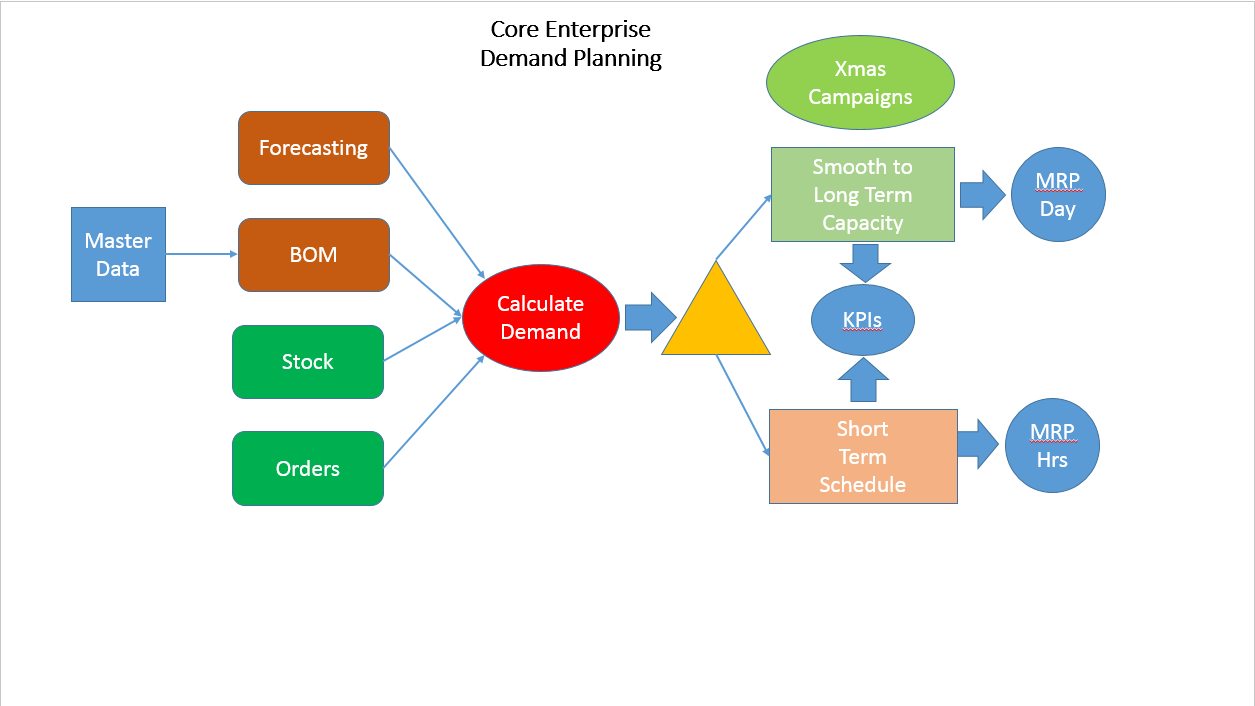The Demand Planning section is the largest section in Core Enterprise.
Master Data & BOMs
Core Enterprise uses a comprehensive version controlled BOM and SKU Product database, this is linked to a resource system holding the speeds and rates at detailed level. A new product development (NPD) system can be used highlight production data required for manufacturing.
Forecast
Core Enterprise has an Account Manager driven forecasting system which allows Account Managers to manipulate forecast demand at SKU and Customer level. The ability to manipulate any of the data over a date range by incremental percentage values or reset values to provided figures. We are also aware that many of our users have alternative methods of maintaining forecast data there is the ability to upload forecasts created in other systems in to Core Enterprise, enabling users can get the benefit of our flexible GUI functionality which displays the data in a chart with easy to use Treeview navigation.
Core Enterprise stores the daily sales data and this is used for a comparison to view historical Customer Actuals against Planned forecasts to help Account Mangers and planner to review the forecast accuracy. Core Enterprise can incorporate a Daily Forecast Editor. This functionality aims to solve issues of inaccurate forecast data by allowing planners to edit weekly forecasts into daily forecasts, for much more finer details of forecasts. The great strength of this tool is the integration of the Customer Daily splits based on historical data at depot level which can then be applied to weekly forecasts at customer level. When forecasts are inaccurate, the planners can directly manipulate the data to ensure the Demand plan accurately reflects what is going to happen based on the most up to date knowledge in the business.
Calculate Demand with Stock and Orders – Manufacturing Requirement
The Planning Activities section is the heart of Demand Planning in Core Enterprise. The Manufacturing Requirement (MR) calculation calculates the requirement to make based on Customer Splits from the Forecast and existing Stock figures. Using Trigger and Cover values specified at SKU level for fine grained granularity the MR calculated a rolling demand plan producing predicted stock levels and manufacturing requirement for each SKU. The MR can run from 14 days to 350 days, with the optimised calculations providing a very fast capacity view of future production.
When Core Enterprise has calculated the required demand the capacity is smoothed in the planning Board to suit the required resources.
Long Term Capacity Planning
The smoothing algorithms in the planning board are designed to cope with most food processing and capacity requirements. However these can be changed and developed to suit the customer. Long term MRP and capacity calculations
Planning Reports
The Planning Reports section contains some Core Functionality that users can use on a daily basis to highlight issues in daily production. We have separated these modules from the rest of the Planning Activities modules so that end users on the shop floor can view this data and not have the ability to amend any of the data. There are a number of controls and checks that can aid planning reports, that are designed and implemented by SFJ Systems;
- The Stock Control module can allow users to view quick graph view of stocks availability and out of date issues in a one colour coded view. For example, the blue colour indicates stock that is unavailable for use as they do not have the contracted life values needed for customers. This screen also provides a great visibility marker of how well a company is performing, we have used this screen over time to get a view of how tight the MR Calculation is improving production and minimising waste.
- The SFDC Check is the next stage on from Stock Check. Using a Generated Daily Production Plan which has been uploaded to SFDC and using the current Stock data uploaded to the Stock Check, Core Enterprise will calculate when products are going to either go out of life or out of Stock. This is a hugely useful tool that is used on a day to day basis to help refine production plans at large complex Food Factories with many production lines and Shelf Life issues.
- EDI Stock check is used to quickly highlight after the Daily sales have arrived ( normally by EDI ) if there is enough Finished Good Stocks to satisfy the Order Requirements. Using this information Planners can quickly identify SKU’s that production need to focus on first in order to meet delivery times required by customers. Again a colour scheme is used to quickly identify problem SKU’s, and also to highlight stock that is in a need to use situation. The ability to also includes figures from today’s daily production plan and also the Customer Daily Split forecast figures, a complex problem is simplified to try and identify where problem are originating from and how best to react to solve any issues.
EDI
The EDI module is where all of the SKU Daily Depot sales are imported to. Core Enterprise stores this data at the lowest level ( SKU – Depot Level ) to enable consolidation and analysis further down the Demand Planning process. The ability to look at this data in Daily/Weekly buckets and by SKU or SKU Categories allows easy navigation though the historical data.
Planning Board
The Planning Board is Core Enterprise mechanism for long term capacity planning at resource and production hours level. We have the Run Rates of all SKU’s we can use the Forecasts or the MR and the Bill Of Materials for the SKU’s to consolidate the Run Times on each Production line to get a view of Labour Hours requirement based on suggested shift patterns for each Production line. Using a colour coding system we can quickly highlight when Production is going to increase the required labour hours over the standards. This proves highly useful for long term labour planning as the look ahead windows are very large, it also enables planners to view labour requirements for busy Production periods like Christmas. SFJ Systems have extended the functionality of the Planning Board by building Smoothing algorithms to drag SKU’s forward by configurable time periods per SKU to balance out Labour hours requirements. We can then download this data into the Core Scheduler and get a finite Schedule out from our smoothed Capacity plans, this completes the loop between long term capacity plans with real time Finite Scheduling.

